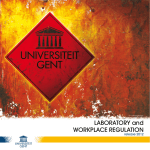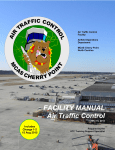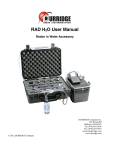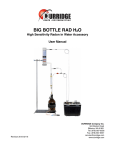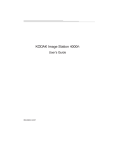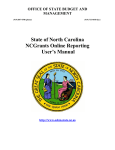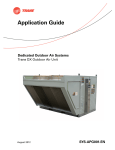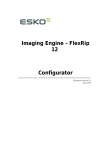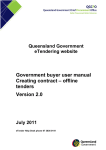Download Radiation Safety User Manual
Transcript
Section Title Page 1.0 2 2.0 3.0 4.0 5.0 6.0 7.0 8.0 9.0 10.0 Control of radioactive materials and radiation generating equipment ALARA USF application for use of radioactive material and/or radiation generating equipment Radiation training requirements Ordering and receipt of radioactive materials Responsibilities of radioisotope users Radioactive waste Personnel monitoring Occupational dose limits Radiation generating equipment USF Blank radioisotope order form USF Blank radioisotope record of use sheet Request to add new personnel form Approved By: Adam Weaver, MS, CHP RS office phone (MDC 1039) Radioisotope order fax number RS office fax number 6 7 8 14 15 17 17 18 19 20 July 1, 2014 USF Radiation Safety Office Contact Adam Weaver Radiation Safety Officer (RSO) Hector Figueroa 3 4 MDC35 Work phone 974-1194 974-5453 974-5311 974-5938 974-7091 USF Radiation Safety User Manual 1.0 Control of radioactive materials and radiation generating equipment USF Research and Innovation maintains two specific radioactive material licenses. 806-1 is type A (3M(I)) broad scope academic license that covers USF nonhuman research uses of radioactive material. 806-5 covers our sealed cesium 137 source license for gamma research irradiators on our Tampa campus. The President of the University of South Florida has designated the Senior Vice President for Research and Innovation to oversee the operation of the Radiation Safety Program at the University of South Florida. The Radiation Safety Officer and the Radiation Safety Committee administer the program. The University of South Florida (USF) maintains a radiation safety program to comply with the regulations in Florida Statue, Chapter 404 and Florida administrative code, 64E-5. USF operates under specific licenses issued the State of Florida, Department of Health, Bureau of Radiation Control and we must comply with the terms and conditions contained in them. All equipment that directly produces ionizing radiation must be registered with USF’s radiation safety office and with the State of Florida, Department of Health, Bureau of Radiation Control, and Radiation Machine Program. Common Radiation generating equipment devices in use at USF include analytical X-rays: X-ray diffraction, X-ray spectrographic or small radiographic cabinets. The Radiation Safety Committee (RSC) is responsible for advising the Senior Vice President for Research and Innovation on all matters pertaining to the safe handling of radioactive materials and other radiation sources at the University of South Florida. The Committee consists of USF and affiliates faculty members with experience working with radioisotopes. The Committee will assure compliance with the regulations concerning the use of radioactive materials found in 64 E-5 F.A.C. of the Florida Department of Health. The RSC approves all principal investigators, approves the uses of radioactive materials, and approves operating procedures/policies governing the use of radioactive materials associated with USF research. Committee meetings are held at least semiannually. The USF Radiation Safety Officer (RSO) functions as the executor of any decisions of the Committee and is accountable to the Committee in this capacity. The RSO reports directly to the Vice President for Research and Innovation concerning all matters relating to Radiation Safety. The RSO has ready access to all administrative levels of the University and the authority to immediately terminate any work with radioactive material and/or radiation generating equipment that is found to be a threat to health, safety or property. The RSO functions as the administrator of the established policies and procedures through the day-to-day functioning of the Radiation Safety office. The Radiation Safety (RS) Office consists of a Radiation Safety Officer, and two support staff members. The RS office staff reviews USF safe handling procedures and practices to ensure USF research operations with ionizing radiation are conducted in a USF Radiation Safety Office Page 2 USF Radiation Safety User Manual safe manner. The RS office orders radioisotopes, completes routine surveys, collects radioactive waste and provides dosimetry services to users. 2.0 ALARA The University of South Florida (USF) is committed to the As Low As Reasonably Achievable (ALARA) concept for working with ionizing radiation. USF maintains a radiation safety program with the objective of maintaining all exposures to ionizing radiation ALARA. USF research operations with radioactive materials and/or radiation generating equipment provide a benefit to a large number of people. USF maintains an ALARA program to ensure our important work with ionizing radiation presents a very low risk to faculty, staff, students and general public. USF ALARA Requirements All laboratories must ensure that radioactive material in storage is shielded to less than (at one foot from storage container) 0.2 mR/hr in a restricted area and 0.02 mR/hr in a nonrestricted area. If shielding to this level is not possible please contact the RS office. Laboratories where radioactive materials are used must have: Current USF radiation permit.(approval of USF RSC). Access to a USF radioisotope user RED notebook. Impervious counter tops. Well-maintained flooring. Waste containers with tight-fitting lids, double plastic lined and properly marked with cautionary signs. Entry door with clearly visible postings. Absorbent paper used in work areas. Paper designating an use area should be held by cautionary tape or be labeled caution radioactive materials Cautionary tape on containers and equipment. Personal protective equipment, such as assigned safety glasses, lab coats, disposable gloves, and proper work area shielding. Issued dosimeters (Luxel badge/finger ring) to be used when working with energetic radioactive material (i.e. P-32, I-125, I-131, Tc-99m, Cr-51). Emergency procedures and RS required documents clearly posted in each use lab. Laboratories using 3H, 35S, 125I, 131I or any other volatile radioisotopes will have access to: A fume hood with an average exhaust face velocity of 80 linear feet per minute, measured on a twelve-point grid, with the sash at a reasonable working height. Participation in the bioassay program, with baselines completed as required. Laboratories using low energy beta-emitters, such as 3H, 14C, 35S, 33P and 45Ca will also have: Access to a liquid scintillation counter for counting wipe tests. USF Radiation Safety Office Page 3 USF Radiation Safety User Manual Laboratories using high-energy beta-emitters, such as 32P will also have: A portable radiation detection meter to perform surveys after each use. Acrylic shielding or other low Z material (contact RSO for guidance). Access to a liquid scintillation counter to count wipe tests. Laboratories using gamma and/or x-ray emitters will have: Lead shielding of the appropriate thickness to reduce radiation levels to <0.2 mR/hr at a distance of one foot from work area. Portable radiation detection equipment (survey meter). 3.0 USF APPLICATION PROCESS Authorization to use radioactive material and/or radiation generating equipment may be granted to any faculty or visiting faculty member that successfully completes the application, meets the requirements for training, and passes the RSC review process. Contact USF RSO to receive an application form. The Principal Investigator (PI) shall complete the application. At USF a PI must have a M.D., Ph.D., or equivalent degree in an appropriate field or be the Radiation Safety Officer. The PI is the person who is primarily responsible for the research operations, the authorized use, supervision, and training of their laboratory personnel. The application form can be easily completed and must include isotopes (or type of radiation generating equipment), limits per isotope needed for research, proposed procedures and locations for use. Application attachments must include diagrams of all laboratories to be used, a current curriculum vita of PI and past experience working with ionizing radiation. The initial review by RSO will be followed by a formal review by USF’s RSC. Once application has been approved, the RSO will issue a permit to PI when lab is ready to receive and use ionizing radiation. The permit may be granted for up to three years. Amendments to the permit are required any time there is a proposed change(s) in isotopes, locations, personnel and/or limits. Minor changes to a permit are approved by the RSO. Major changes (large increases in limits or new radiochemical procedures) must be reviewed by the RSO and RSC in the same manner that new applications are processed. All changes require a typed memo or e-mail to the RSO reflecting the requested changes needed by PI. Temporary job sites and cruises are an unique request and will be treated separately on a case-by-case basis. These requests are evaluated and approved by RSO only if there are sufficient procedures as well as facilities and equipment to preclude the loss of radioactive material. USF Radiation Safety Office Page 4 USF Radiation Safety User Manual Temporary Job Sites. Adequate procedures covering the following topics must be addressed with request: 1) Handling procedures that demonstrate containment and safe handling of the radioactive material at all phases of the experiment. 2) Transportation procedures that demonstrate compliance with D.O.T. requirements, as well as securing and double containment if in a liquid or other dispersible form. The RSO is responsible for preparation of any package for transportation, if not in an original unopened package. 3) Storage locations for radioactive material must be adequately shielded, where applicable, and secured. 4) Control procedures to preclude unauthorized access to radioactive material must be demonstrated at all times. 5) Emergency and contamination procedures must be adequate to preclude loss of radioactive material to the environment. Research Cruises. Adequate procedures for compliance with temporary site work must be detailed in addition (above requirements) to the following: 1) Requests for approval for cruises outside the territorial waters of Florida are to be made approximately 4 weeks in advance to allow the RSO time to seek reciprocity from the Nuclear Regulatory Commission. 2) Pre-cruise meeting with the Captain or first mate to explain the nature of the radioactive material on board, its location, safety protocols, including segregation and security of the inventory and the waste shall be performed by PI or RS office staff. Full Permit Review A full review of a permit is required: 1) at least every three years, or 2) after revocation or expiration of a permit. PI’s must fill out a current USF application form. Violations of USF radiation safety requirements may result in: Holding Orders Repeated (as determined by RSO) radiation safety violations may cause the radiation safety office to hold all new radioisotope orders from PI temporarily until RSO and PI have agreed on correction actions to prevent violations. RSO shall report any holding of orders to RSC chairperson. Suspension Permits may be suspended for some time period when the Radiation Safety Officer with follow-up conference with the RSC chairperson. Suspension of a permit will result if RSO: 1) Discovers any incident where there is an immediate danger to life and property as a result of a misuse or loss of radioactive material or a radiation-generating device. 2) Determines that there was an instance of using radioactive materials in facilities outside the principal investigator's permitted use area. 3) Determines that there have been multiple or repeated instances of noncompliance involving individuals or facilities within the principal investigators permitted use area. 4) Determines that PI has purposely not followed USF radiation safety requirements. Revocation or Probation The severity of the details and circumstances of multiple violations or a major noncompliance will determine by the USF radiation safety committee whether suspension or revocation may be required. USF Radiation Safety Office Page 5 USF Radiation Safety User Manual 4.0 Radiation Training Requirements PERSONNEL CLASSIFICATIONS AND TRAINING REQUIREMENTS The USF radioisotope safety training courses are conducted under the direction of the Radiation Safety Officer. Principal Investigator (PI): The PI must have either a M.D. or Ph.D. in an appropriate field or be the Radiation Safety Officer. This person is primarily responsible for the permit operation and the authorized use, supervision and training of their laboratory personnel. At least one year of experience is required along with completion of USF four-hour training course or equivalent (documented) training within the past three years, as approved by RSO. One hour refresher training is required every three years. Research Associate (RA): The RA can be a faculty/staff/post doctorate/graduate student. The RA must be a researcher with six months experience in handling radioactive materials and is authorized to supervise and train other laboratory personnel. Four hours of USF radiation safety training is required, initially. Refresher training is one hour annually. Radioisotope Worker (RW): The RW is a staff member or student of at least 18 years of age and who must be supervised by PI or RA. RWs must complete USF’s four-hour radiation safety training course, initially. No previous radioisotope work experience is required. Refresher training is one hour annually. USF Initial Four (4) Hour Training Course: This written course is required for all new laboratory personnel requesting authorization to work with radioactive materials and provides the individual with a comprehensive overview of the safe use of radioactive materials in a USF research laboratory. Topics covered include: Part 1 Radiation Physics Part 2 Radiation Units Part 3 Properties of commonly use radioisotopes used in research at USF Part 4 Natural and Man-Made Sources of Ionizing Radiation Part 5 Biological Effects of Ionizing Radiation Part 6 Regulations and USF Radiation Safety Program Part 7 Radiation Monitoring at USF Part 8 ALARA Part 9 USF Radiation Safety Requirements Part 10 Detecting and measuring radiation Part 11 Radioactive Waste Part 12 Laboratory Accidents and Spills Involving Radioactive Materials The final portion of the training is a practical “On the Job Training” (OJT) conducted in the work area of the new laboratory personnel with a member of the USF radiation safety office staff. USF Radiation Safety Office Page 6 USF Radiation Safety User Manual After successful completion of examination (passing grade of 70), the individual receives a USF training certificate to be kept in their laboratory radioisotope records RED notebook. Any individual(s) failing to achieve a passing grade will be administered a make-up exam(s) until they demonstrate an acceptable comprehension of the training materials. USF Refresher Training: This refresher training is provided to review the responsibilities regarding use of radioactive materials. The job specific (PI, RA and RW) information is provided in the form of a handout detailing USF handling requirements and responsibilities. An exam is required and a passing grade of 70% must be obtained. A training certificate is mailed to employee and kept on file in the individual’s personnel folder in the RS office. 5.0 Ordering and Receipt of Radioactive Materials Ordering Radioisotopes As part of the requirements of our broad scope license, all purchases of radioactive material must be approved and orders placed by the Radiation Safety Office. The RS office has quotes with commonly used radioisotope vendors. Frequently used isotopes may be added to these quotes by notifying the RS office. Placing An Order All orders for radioactive material are placed with the Radiation Safety Office by FAX (813) 974-5938, hand delivered to our office at MDC 1039 or mailed to us at MDC Box 35. Orders must be received by 3 pm to be processed before the end of the workday. There is a copy of the USF Radioisotope Order Form (blank form on page 18). You may use it as a master to make copies to place future orders. You MUST call and talk with a radiation safety office staff member to cancel any order placed. Replacement orders must also be approved by RS office. The RS office staff must approve ALL orders for radioactive material with the vendor. The RS office is responsible for the receipt, in processing, monitoring and delivery of the shipment to your laboratory for the Tampa Campus. Receipt of Radioactive Shipments. Radioactive shipments sent to Permit Holders at the Tampa Campus are received and in-processed by RS office personnel. The RSO monitors for possible radioactive contamination and deliver the packages to the laboratory along with the appropriate paperwork for your records. Permit Operations Located on Branch Campuses. Laboratories at Tampa General, Bayboro Campus, and All Children's Research Center may elect to take direct receipt (direct receipt option), with the RSO approval with the provision that receipt, in processing and monitoring tasks are performed and the labs maintain records. Upon receipt of radioactive shipments you must contact the RS office. The calibration date, activity received and the arrival date/time must be given to the RS office. RSO personnel will then issue the R# for that shipment. USF Radiation Safety Office Page 7 USF Radiation Safety User Manual Responsibilities of labs requesting direct delivery option. a. Upon receipt of each shipment packages are monitored to ensure that the integrity of the outer container has not been breached. A wipe test is required if package has a DOT radioactive label (Usually a White I or Yellow II). b. Make a copy of a blank "Record of Radioisotope Use" sheet located in the Appendix B. Fill in the appropriate blanks, including completion of the lines concerning the incoming wipe test and then call the RS office for the R#. This R# should be written on this sheet in the upper right-hand corner AND on the stock vial. Remember that if you aliquot any or all of the activity from this stock vial, then you are to mark the new container, i.e. eppendorf, test tube, etc. with this same R#. c. Remove or disfigure (with black ink) the shipping labels and any words referencing "radioactive" from the package in which your radioisotope was shipped prior to disposal as trash. Transfer of radioactive material is prohibited without prior approval from RSO. It will be permitted on a case-by-case basis only. Unauthorized transfer of isotope is considered a major permit violation and may result in the suspension of permit privileges. Failure to comply with these requirements may result in punitive action by the USF Radiation Safety Committee. 6.0 Responsibilities of Radioisotope Users Safe Handling Practice All personnel working with radioactive material are required to comply with these safety rules. 1. Smoking, eating, drinking, application of cosmetics, storage of food, or evidence thereof, are prohibited in a laboratory where radioactive material is permitted. 2. Personal belongings are to be kept separated from use areas. 3. Designated mechanical pipettes shall be used; these shall be marked with "CautionRadioactive Materials" tape or stickers. 4. Work with radioactive material should be done expediently, but with care. The concept of time, distance and shielding should be used to minimize exposure. 5. Work surfaces shall be covered with absorbent paper with the paper side up/plastic side down to confine spills and aid in minimizing contamination. Cautionary tape should be used to affix the paper to the bench top. 6. Use of disposable gloves is required; the use of double gloves is recommended. Always remove the outer gloves after using the stock vial. Put on a new pair of gloves and proceed with the experiment. Remove your protective apparel, wash and monitor your hands prior to leaving the laboratory premises. 7. Shield all sources of radiation not being used to an exposure rate <0.2 mR/hr at one (1) foot from the shielding. 8. Personnel that have been issued personnel monitoring badges are required to wear them when working with radioactive material or when in a lab where radioactive USF Radiation Safety Office Page 8 USF Radiation Safety User Manual material is used. Badges should be worn unshielded on breast pocket or collar. TLD finger rings are issued to personnel that handle beta-emitters with energies >150 keV or any gamma emitter and are to be worn so that the label is toward the palm of your dominant hand and inside glove. 9. Perform daily surveys and/or wipes tests of all areas where radioactive materials are used. Upon receipt of radioactive material, a wipe test is required of outside container holding stock vial. Perform weekly wipe tests of isotope storage container(s) and/or container(s) where radioactive waste is stored. Written records of these tests must be maintained on the wipe test schematics provided by the RS office. 10. Radioactive waste is to be disposed of only in designated, labeled, and properly shielded containers. Security of Inventory Principal Investigators and staff shall provide security adequate to "prevent the unauthorized removal of radioactive material" from any location where radioactive material is used or stored. Researchers must take the following steps to provide security of radioactive materials in order to remain in compliance with USF radiation safety policies, our radioactive material license requirements and with applicable State of Florida regulations. 1. Keep all radioisotope stock vials in a lock box approved by USF Radiation Safety. If the lock box breaks, cannot be locked, or if you cannot remove key, contact the USF Radiation Safety Office (974-1194) immediately to arrange for repair or replacement. When stocks vials are in use, they must not be left unattended at any time. All radioisotope stock vials must be secured when not in use. 2. Control access to laboratories. Close and lock all entry doors when laboratory is unattended. 3. Maintain an inventory of all radioactive materials. Conduct a visual check of stock vials during your weekly wipe test of radioisotope storage boxes. Mark the check box on (or add a note) the weekly lab survey sheet that inventory was checked. This sheet must be maintained in your RED notebook. Report any missing inventory to the USF Radiation Safety Office immediately. 4. Know who is in your laboratory. Persons without appropriate justification for being in lab should be asked to leave. Immediately report any suspicious activity or unusual inquiries about radioactive materials to the lab supervisor, USF Radiation Safety Office, University Police, or building security as applicable. Failure to follow these requirements may be considered a major violation of your radioisotope permit. Proper Marking of Laboratories, Areas and Equipment A "Caution - Radioactive Materials" sign must be conspicuously posted on the doors of the laboratories and/or areas where radioactive material is used or stored. The RS office USF Radiation Safety Office Page 9 USF Radiation Safety User Manual will supply the appropriate signs. All equipment contaminated with radioactive material is to be marked with signs, decals or tape to that effect. The RS office will affix a small label on the access door of every use room or area with emergency contact information. If you wish to use an area (not on your permit) you must first amend your permit. You may only do this by sending a memo or E-mail to the Radiation Safety Officer requesting changes to permit use areas. You must also have approval of area owner. Posting Requirements The current "USF Safe Handling Practices”, the DH Form 1081 "Notice to Employees" and "USF Emergency Procedures for Radiation Incidents" will be posted in all permitted labs. Take the time to read these documents. Work Surfaces, Floors and Equipment All work surfaces should be made of impervious materials. The work surfaces should have absorbent paper covering them during all procedures. Floors may be tiled, but should be free of divots, cracks, etc. Work orders for repairs of such are the responsibility of the PI. Facility vacuum lines must not be used with radioactive materials unless at least one trap is used between your equipment and the line. A separate vacuum, which exhausts into a fume hood, is recommended. All equipment that is used in association with radioactive material must be properly marked with cautionary tape, labels or signs. Fume Hoods Fume hoods are required for use with tritium, sulphur-35 and iodine-131 or iodine-125. The face velocity, measured on a twelve-point grid [four points across and three points high], must average to 100 linear feet per minute with the sash at a reasonable working height. The exhaust should be 100% throwaway to the outside environment. If your fume hood is not working, stop work – close sash and contact the RSO. Fume hoods are checked annually by RS office. Radiation Detection Equipment An operable and calibrated survey meter is required for each lab where energetic betaemitters [E>700 kev] or any gamma-emitters are used. Laboratories located side by side and adjoined by a door are considered as one laboratory, whereas, labs accessible only by a door leading from the hallway are considered as two separate rooms. While the Principal Investigator is required to purchase meter(s) to meet the needs of the research, these purchases should be cleared through the RSO to ensure that the unit may be calibrated on-site by the RS office staff. If the RS office staff cannot calibrate the meter it will have to be returned to the manufacturer for recalibration at least annually, at the PI's expense. Re-calibration of meters by the RS office is a free service. USF Radiation Safety Office Page 10 USF Radiation Safety User Manual USF License Requirements: The University of South Florida has an academic broad scope radioactive material license (806-1) which clearly states the requirements we all must follow to allow the University to continue to use radioactive materials in our programs. USF radioisotope users must perform the follow surveys. Daily Radioisotope Use and/or Receipt of Radioactive Material A survey with a portable radiation survey instrument shall be completed at the end of each day whenever radioactive materials are used. If the survey instrument is not capable of detecting the radioisotope in use then a wipe test for removable contamination shall be performed. The users must conduct an area survey in at least six locations with a meter or wipe tests (some labs must do both) of the radioisotope use area(s) and record after each daily use of radioisotope(s). The objective is to catch contamination before it spreads. The type (meter, wipe or both) of survey required depends on radioisotope or combination of radioisotopes being used in lab. All daily surveys must be recorded on your laboratory schematic by the end of the working day. If your laboratory receives a radioisotope package delivery, you are required to a wipe test the outside surface of each container holding the stock vial by the end of the day of receipt. This is to ensure that there is no removable surface contamination on the outside of these containers. If your lab uses the radioisotope on the day of receipt you must also survey the lab. The receipt wipe test data must be recorded in the space at the bottom of the record of use sheet by the end of the working day. NOTE: The USF Radiation Safety Office will issue to each radioisotope use lab a laboratory schematic that is not dated. The lab personnel need to make multiple copies of this schematic and use them for recording the daily use wipe tests/surveys. Remember to sign and date each one as they are completed. USF’s use area survey requirements for most common radioisotopes. Lab uses 3 H (Tritium) 35 S 14 C 33 P 45 Ca 51 Cr 125 I 32 P 99m Tc 131 I USF Radiation Safety Office Type of survey required wipe tests wipe tests wipe tests wipe tests wipe tests meter readings meter readings meter readings meter readings meter readings Page 11 USF Radiation Safety User Manual If you use radioisotopes in a common radioactive use room, you will be responsible for doing a survey with a meter, wipe test or both and recording those contamination checks on the lab schematic for that room. These lab schematics will be kept in the RED notebook in those common use laboratories. A wipe test shall be conducted using a damp (with tap water) cotton tip swab. Wipe an approximately 100cm2 area (about the size of a U.S. dollar bill). Count the cotton tip (with at least 3 ml of “safe” scintillation cocktail) in a liquid scintillation counter (set to open window). The results should be reviewed and data taped on the appropriate lab schematic, sign and date the form. If the open window count exceeds 200 cpm above background, you should recount the wipe vial. If result is still above 200 cpm, you must decontaminate area and collect another wipe. Background should be determined using a new/unused damp cotton tip swab counted (same LSC) before or after area wipe samples. A meter reading two times background in any part of your lab area that has no nearby radioactive materials or radioactive waste storage shall be decontaminated. If area cannot be cleaned after two attempts, contact USF Radiation Safety office staff for assistance. Weekly Wipe Tests of Radioisotope Inventory in Storage and Radioactive Waste Containers. All USF radioisotope use laboratories must clearly demonstrate that there is no removable surface contamination on inventory storage (Plexiglas) containers as well as on the outside of all radioactive waste containers that have waste stored inside. You make this determination of outside removable radioactive contamination by performing a wipe test. These wipe tests must be performed weekly by each radioisotope use lab that has radioactive material inventory and/or radioactive material stored in waste containers. The wipe tests must be done on every radioisotope inventory storage box that has radioactive material stored and on every radioactive waste container that has radioactive material stored inside. You are to wipe test the outside of these containers only and record these weekly contamination checks on the pre-dated laboratory schematics. You should complete the wipe test prior to preprinted date on the bottom of schematic. NOTE: If your Principal Investigator is assigned more than one room for radioisotope use and those rooms do not have either radioisotope inventory or radioactive waste storage, then they are exempt from the weekly contamination checks. In addition, if you do not have any radioisotope inventory/waste/use in those rooms during the week, then you need to write on the weekly schematic, “No Radioisotope Work” and sign and date the schematic. Personal Contamination Monitoring Checks Before Leaving Lab Whenever you are working with radioactive material, you should check yourself for personal contamination before leaving the laboratory. This is something that you should be doing as a regular part of your safe working practices. All USF lab personnel who are working with 32P, 51Cr, 125I, or 99mTc should survey themselves with the meter before leaving the laboratory for any length of time, not just at the end of the working day. You will not have to keep a record of these contamination checks. Remember, your survey USF Radiation Safety Office Page 12 USF Radiation Safety User Manual meter, if equipped with a pancake probe, will also pick up higher levels of 33P, and 35S contamination. If you find any personal contamination above background you need to notify the USF radiation safety office immediately. Radioactive Contamination and Exposure Limits Restricted Area. A restricted area is the principal laboratory where radioactive material is permitted to be used. All use areas, use equipment, storage areas, and waste areas and containers must be decontaminated after each days use. Survey readings and wipe surveys for removable contamination should indicate that contamination levels are as close to background as practicable. For most isotopes, contamination levels should be reduced to 400 dpm (200 cpm) per 100 cm2 wipe or 0.2 mR/h above background at 1 foot. If these levels are not achievable then contact the RS office. Unrestricted area. An unrestricted area is one where non-occupational workers may have access, such as common equipment rooms, hallways, offices, etc. Background radiation levels are to be maintained in these areas. Repair and Maintenance of Any Use Equipment. All equipment is to be surveyed/wipe tested and proven to be free of contamination prior to its repair or servicing. Contact the RS office before any repair or maintenance for assistance. Closing Out A Facility/Area or Disposal of Equipment. If the routine use of radioactive materials is to be interrupted or discontinued in any manner and/or if any equipment is scheduled to be repaired, salvaged or no longer used with radioactive materials, then wipe tests are required to ensure that no contamination is present. A record will include a schematic/drawing of the room or equipment and one wipe test needs to be performed for every four (4) square feet of surface area in a room or covering at least 25% of every surface of a piece of equipment. Radioactive material use must not occur during any renovation work or following close out. Contact the RS office for assistance and guidance. All scintillation equipment MUST be checked by RS office prior to disposal. A radioactive source may be within the equipment. Record Keeping Each permit holder must maintain records of inventory use, waste disposal records, contamination control, training records and any other document pertaining to the permit operation. All documentation is to be kept in a red, three-ringed binder provided by the RSO. A blank record of sheet is on page 19. A summary of what is required is listed below. 1. Record of Radioisotope Use. This sheet is issued with each radioactive shipment and is designated with an inventory number (R#) in the upper right-hand corner. USF Radiation Safety Office Page 13 USF Radiation Safety User Manual Individual entries should be made at any time that an aliquot of activity is removed from the stock vial. The practice of removing all of the activity from the original container and creating sub-stocks are to be recorded on this use sheet. Any sub-stock containers should have the original R# affixed to the container, i.e. eppendorf tube, test tube, etc. After the entire radioisotope is used and the balance is zero, place record of use sheet by waste container for pick up by RS office staff. You may also mail (MDC 35) or fax completed record of use sheet(s) to RS office. 7.0 Radioactive waste PI costs for radioactive waste disposal is covered in USF policy 0-307. All radioactive wastes must be segregated into three (3) general categories: dry solid, bulk liquid and scintillation (LSC) vials. The dry solid category is based on percentage moisture by volume. Therefore, stock vials that are either decayed or no longer needed that have tight-fitting caps and less than ten (10) milliliters of liquid are to be discarded in the dry solid waste. The following solid radioisotope waste must be segregated into separate waste containers provided by RS office: P-32, P-33, S-35, I-125, Ca-45, Cr-51, Tc-99m, or other isotopes with a half-life less than 90 days. H-3 and C-14 waste may be placed together in a single waste container. No scintillation vials are allowed in dry waste containers. Bulk liquid (water based) radioisotope waste must be disposed in containers provided by RS office. Most liquid waste can be combined into a single container (except Cr-51 and I-125, which must be separated individually). Contact RS office for proper liquid containers. Scintillation (LSC) vials must be segregated into separate waste containers provided by RS office. P-32, P-33, S-35, I-125, Ca-45, Cr-51, Tc-99m, or other isotopes with a half-life less than 90 days may be placed into one container. H-3, C-14 or routine wipe tests vials may be placed together in a single waste container. No waste tag entry is required for routine wipe test waste. Do not place solid waste (gloves, paper etc.) into vial waste containers. Scintillation cocktail must be the ecologically safe/biodegradable type. Mixed Waste Radioactive Mixed Waste (RMW) is defined as waste, which contains both a radioactive and a chemically hazardous component. Any operation with a potential of RMW must be approved by USF’s RSO prior to generation. Bio-hazardous (Sharps) Waste Sharp radioisotope contaminated waste can be needles, razor blades, broken glass or other items that could injured someone handling waste. This waste must be placed in properly designated (outside labeled with radioisotope) waste container, which can be provided by RS office. Do not place any sharp waste into dry waste or vial containers, as this is would be a serious violation of your permit requirements. USF Radiation Safety Office Page 14 USF Radiation Safety User Manual Waste Tags. Each lab will be issued multiple blank waste tags comprised of three different colored paper tags. Press down hard with a ballpoint pen to make sure that the entries are legible on the last sheet as this is your copy. A waste tag is required on each waste container for each category of waste that is ready for pickup. The top of the waste tag must be completed for RS office to pick up waste. Date placed into waste container, isotope R#, the activity in microcuries (Ci) and initials of person placing waste into container must be included on waste tag. Multiple entries are allowed on waste tag if radioisotope and physical form are the same. If the tag is not ready or available near waste, RS office personnel will not remove waste from the area. Waste tags are both a record of the final disposition of your inventory as well as a record of the weight of the waste removed. After waste pick up, the pink copy of the tag(s) should be filed in the RED book. Examples of a Properly filled out waste tags: Liquid X Solid Vials Solid X Liquid Vials PI Name/Permit: __Larson/RS101_____ PI Name/Permit: __Weaver/RS101_____ Isotope:______P-32_______________ Isotope:______S-35_______________ Date Disp. R No. Activity (Ci) Initials Disposer Date Disp. R No. Activity (Ci) Initials Disposer 3/12 18100 45.3 RL 4/6 19101 5.3 AW 3/15 18203 333 RL 4/15 18999 7.9 AW Waste Minimization Every effort should be made by USF radioisotope users to find alternatives to prevent the generation of radioactive waste, reduce the volume by proper handling and by recycling or by re-evaluating the procedure generating the waste. 8.0 Personnel Monitoring Personnel that are likely to receive ten percent (10%) of the maximum dose limits of the State of Florida will be classified as occupational workers and, as such, will be required to participate in the personnel-monitoring program. Occupational workers are required to complete a Personnel Monitoring Request form (see page 20) from which the RSO requires a permanent address and information as to whether you have had previous radioactive material handling experience. You must have a unique (employee or ID) USF Radiation Safety Office Page 15 USF Radiation Safety User Manual number to be issued a dosimetry device. We are required by regulation to get any prior records/history of exposure and update our files with this information. Luxel Devices USF workers that handle photon (gamma or X-ray) emitters with energies greater than 50 keV or energetic beta emitters with energies greater than 300 keV, will be issued the appropriate monitoring devices, as determined by RSO. These devices are usually in the form of either a ring or a clip-on badge. The badge is to be worn, unshielded, between the collar and the lapel. A TLD ring will also be provided for all personnel using beta emitters with energies greater than 150 keV. The ring should be worn with the label toward the palm on the dominant hand and under your glove(s). All dosimeters are exchanged on a bi-monthly basis. The Radiation Safety Officer reviews all bimonthly dosimetry records. The Radiation Safety Officer routinely discontinues the badge/ring service for all individuals working in laboratories that are either inactive or not currently working with energetic isotopes. Badge reactivation takes a week to 10 days, so plan accordingly when ordering isotope. The RS office will not order isotopes until the dosimetry badges have arrived! Whenever a female isotope worker becomes pregnant, she should formally notify (letter or E-mail) the Radiation Safety Officer. The mother assumes all risk until she specifically declares her pregnancy to the Radiation Safety Officer. Upon receipt of this notification, the Radiation Safety Office, the University and the Principal Investigator will ensure that the female worker's exposure will not exceed 500 millirem to the fetus. After a female occupational worker voluntarily notifies the Radiation Safety Officer and Principal Investigator in writing that she is pregnant she is considered a declared pregnant worker. Section 64E-5.311, F.A.C., places different radiation dose limits on declared pregnant workers than on adult workers. Specifically, a declared pregnant worker who chooses to continue working as an occupational worker, has a dose limit for the embryo/fetus from conception to birth (entire gestation period) of 500 mrem. Declared pregnant workers at all times when they are at work will wear an additional monitoring device. It is the responsibility of the pregnant worker to decide when or whether to formally declare her condition. If a woman chooses not to declare her pregnancy, she will continue to be governed by the guidelines for adult occupational exposure. Urinalysis for Detection of Tritium (H-3) Upon entry into the USF Radiation Safety Program, all personnel working for a PI with a H-3 permit limit equal to or above 25,000 microcuries (Ci) are required to submit urine samples for radioanalysis to determine a baseline/background level. Thereafter, a sample may be required from personnel in a lab where more than 25,000 microcuries (Ci) of H3 are used in any one-month, at any one time, or over a three-month period. Bioassays should be taken within 4 to 48 hours after use. The RS office will notify all affected USF Radiation Safety Office Page 16 USF Radiation Safety User Manual personnel and issue a kit. Any personnel involved in a spill must notify the RSO and may be required to submit a sample. Sample kit procedure. Kits are available from RS office. Please call for locations. The kit includes a gross collection cup, a transfer pipettes, a minivial and cap and instructions. The initials of the participant and permit number should be written on the cap of the minivan [DO NOT WRITE ON THE SIDE OF THE VIAL]. The participant is to collect the sample and pipette 0.5 ml of urine into the minivial and secure the cap. No scintillation cocktail is to be added by the participant. The RSO personnel will add the cocktail and count sample on a liquid scintillation counting system. If results exceed USF tritium bioassay action level the individual and PI will be notified. Thyroid Scanning All personnel that work in a lab where radioiodine is used will have their thyroid scanned to determine a baseline level. Thyroid scans are required of any person using 1000 Ci or more of unbound, or 10,000 Ci or more of bound 125I or 131I. Notify RS office to set up time for scan. If possible the scan should be performed within four to twenty-four hours after use, as this is the minimum time for the iodine to incorporate in thyroid. 9.0 Occupational Dose Limits The annual occupational dose limits as specified in the Code of Federal Regulations, Title 10, Part 20, "Standards for Protection Against Ionizing Radiation," and in the Florida Department of Health/Bureau of Radiation Control, Chapter 64E-5, "Control of Radiation Hazards Regulations" are listed below: The annual occupational dose limits for adults are: A total effective dose equivalent equal to 5 rem (0.05 Sv); or The sum of the deep dose equivalent and the committed dose equivalent to any individual organ or tissue other than the lens of the eye equal to 50 rem (0.5 Sv). The annual dose limits to the lens of the eye, to the skin, and to the extremities are: An eye dose equivalent of 15 rem (0.15 Sv). A shallow dose equivalent of 50 rem (0.5 Sv) to the skin or to any extremity. The dose to an embryo or fetus for women who have declared pregnancy: The dose to an embryo or fetus during the entire pregnancy shall not exceed 0.5 rem (5 mSv). It is recommended that no more than 0.05 rem (0.5 mSv) be received by the embryo or fetus in any one month. 10.0 Radiation Generating Equipment Any PI that has a research need to purchase, borrow, or build a radiation generating device shall notify USF’s RSO in writing for review. RS office personnel will inspect X-ray systems and facility every year during the month of January. Any changes to X-ray systems (new tube, design modifications, etc.) must be approved by USF’s RSO. USF Radiation Safety Office Page 17 USF Radiation Safety User Manual USF RADIOISOTOPE ORDER FAX NUMBER: 974-5938 RADIOISOTOPE ORDER FORM INSTRUCTIONS: To avoid any delay in the processing of your radioisotope order, please fill out this form in its entirety. Make sure you have entered a PURCHASE ORDER NUMBER and that this order is SIGNED BY THE RADIOISOTOPE PERMIT HOLDER. Also, if there are any special instructions be sure to include them in the space provided. For fastest service fax the completed / signed order to 974-5938. PLEASE Type or PRINT CLEARLY! DATE ORDER PLACED: RADIOISOTOPE PERMIT #: RADIOISOTOPE PERMIT HOLDER: MANUFACTURER/VENDOR: PURCHASE ORDER NUMBER: CATALOG NUMBER: RADIOISOTOPE: PRODUCT NAME: µCi ACTIVITY ORDERED: DELIVERY DATE TO LAB: NOTE: ASAP could mean an extra handling charge. Use a specific date. DELIVER TO BLDG & ROOM #: LAB PHONE NUMBER: LAB CONTACT PERSON: SPECIAL INSTRUCTIONS: SIGNED: PERMIT HOLDER ONLY Call 974-5311, 974-1194, or 974-5311 to cancel order or with questions USF Radiation Safety Office Page 18 USF Radiation Safety User Manual R#______________ University of South Florida Record of USE Radioisotope: _____________Permit Holder: ________________ Permit #_____ Compound: ____________ Receipt date: _____________ Starting Ci: _______ Entry # Use date Users Initials Comments Amount Ci removed Remaining Inventory Ci 1 2 3 4 5 6 7 8 9 10 11 12 13 14 15 Disposal PI package survey by: ___________________________ Inner package wipe result: _____________ (open cpm) Background: _________________________(open cpm) Note: This form is to be used to record the use of every Ci of activity removed from stock vial. Each time an aliquot is removed, an entry should be made indicating the balance of activity remaining. DO NOT account for decay. Remember to label samples/aliquots removed with R#. When balance of activity reaches zero and waste is ready for collection, a copy of form should be turned in to USF radiation safety office – MDC 35 (or fax to RSO at 974-7091). USF Radiation Safety Office Page 19 USF Radiation Safety User Manual Request to Add New Personnel to Permit and Monitoring Fax completed and signed form to 974-7091 or send via e-mail to [email protected] Check appropriate category: Faculty___ Staff___ Visitor___ Post Doc.___ Grad. Student___ Undergrad *Minor ___ *Under 18 requires approval from USF RSO. PLEASE PRINT CLEARLY: Name _______________________________________ Sex [circle] Female Male Working for [circle] USF Moffitt Employee ID ______________ Department____________________ Office Phone #____________ Lab Phone #____________ Permit Holder: _____________________ Radioisotopes to be used: ____________________ Starting Date for usage: _________________________ Date of birth: ___________________ E-mail address: _________________________ Your home address_______________________________________________________________ Street Apt # _______________________________________________________________________________ City State Zip Have you ever worn or are currently wearing a radiation monitoring badge or ring at another institution? Yes____ No____ Are you currently employed at another institution where you work with radioactive materials and/or radiation generating equipment (i.e. X-ray device)? Yes____ No____ If you have answered yes to one or both of the above questions, please complete the following. You will be mailed a “Release of Exposure Records” form to sign. The State of Florida requires USF to obtain past exposure history for all employees. Institution(s) Complete Mailing Address Certification I agree to follow the University’s regulations regarding radioactive materials and/or radiation generating devices. If I leave the university, I will notify the Radiation Safety Office and provide a forwarding address, if different from the current address on file. I will notify the RSO of any changes or additions in work location or isotopes that I work with as soon as the change is known. ____________________________________ Applicant Signature USF Radiation Safety Office __________________________ Date Page 20




















